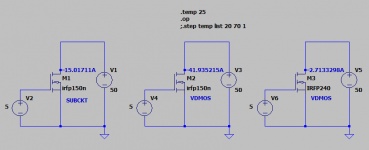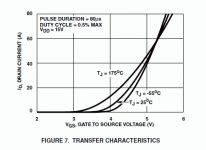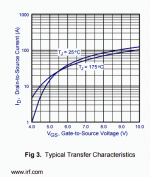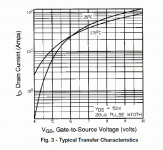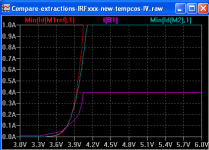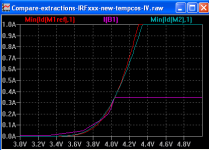Thank you Ian
I think there is a problem in the ID / VGS curve
With SUBCKT from infineon I have 15A with 5V VGS and 50V VDS like the datasheet, with the VDMOS i have 41A
I checked with the IRFP240 VDMOS and there it is good, 2.7A in same situation like datasheet
I think there is a problem in the ID / VGS curve
With SUBCKT from infineon I have 15A with 5V VGS and 50V VDS like the datasheet, with the VDMOS i have 41A
I checked with the IRFP240 VDMOS and there it is good, 2.7A in same situation like datasheet
Attachments
UltimateX86,Thank you Ian
I think there is a problem in the ID / VGS curve
With SUBCKT from infineon I have 15A with 5V VGS and 50V VDS like the datasheet, with the VDMOS i have 41A
I checked with the IRFP240 VDMOS and there it is good, 2.7A in same situation like datasheet
I think you have opened a can of worms.
I fitted to the ON-Fairchild 2002 IRF150N Datasheet Fig-7 (attached) which shows 42A at Vgs=5V, which is what you read.
The Infineon-IR IRF150N Datasheet is the same as the IRF150 Datasheet (attached).
This may be an oversight on the behalf of IR by copying the old datasheet for the upgraded IRFP150N. If so use the ON-Semi model as I supplied.
If you want a model to match the IRFP150N that you are using you need to do a test to see which of the two IRFP150N models you need.
BTW attached is your jig with my IRFP150N and now with the Infineon IRFP150. You can see the Id for the IRFP150 is the same as the MODPLEX subcircuit.
Also in the jig I added a convenient way to convert my IRFP150N back to the IRFP150 using the 'ako:' statement below:
.model IRFP150 ako:IRFP150N Kp=22 Rs=30m
Add this to your circuit and you can enable it to select the IRFP150 or the Infineon/MODPLEX IRF150N) for DC conditions (the AC property remains the faster ON-Semi IRFP150N).
BTW I ammended the model code in the attached to better match the datasheets I used.
Attachments
Hi Toni,Thanks to Ian!
One question: all P-channel devices have positive Vtotc values. Could this be correct? The default value is for all devices vdmos normally -1mv/C
BR, Toni
I raised this with MIke but no reply. The updated Help file (May 2019) says the default value for the vdmos is -1mv/C. But I think this should be edited and qualifed in the help file as applying to the n-channel, and the p-channel is default +1mV/C to make it unambiguous.
I understand other MOSFET models have a +ve Vtotc for p-channels to get the same effect as n-channel's which use a -ve Vtotc (ie Vto reduces with higher temp). A +ve Vtotc for p-channels in the new VDMOS gives the correct effect.
That's why I am putting a "+" on my models like "Vtotc=+6m" to emphasise it must be +ve for the pchan.
Cheers,
Ian
Dear Ian,
thanks for update. I asked because vtotc is negative for both N- and P-channel JFET in standard.jft
I'm still confused about this.
BR, Toni
EDIT: Just realized that vdmos models have

Thanks so much for providing us the models!
thanks for update. I asked because vtotc is negative for both N- and P-channel JFET in standard.jft
I'm still confused about this.
BR, Toni
EDIT: Just realized that vdmos models have
- vto is positive on N-Channel and vtotc negative
- vto is negative on P-Channel and vtotc positive
Thanks so much for providing us the models!
Last edited:
HI,
In this new spice model, it is possible to keep the Tjp param to be able to vary the temperature separately from the complete assembly ?
thanks
Hi UltimateX86,
Yes, you can either append the Temp=Tjp after the name of each instance,
or you can add it globally to an ako statement so all MOSFET's of that name get changed.
See the attached.
But you can't ako: both param changes and global temp for that model at once (a bug?). See the ako: code I provide (enable one and disable the other proves it).
BTW you can step Temp the old way like this:
.Temp 20 40
.param Tjp=Temp+50
where the "50" is the temp rise for the power transistors above ambient since you usually want Tjp to increase with ambient. .param Tjp=Temp+50
@Eric06 ZVN it's almost done.
Attachments
ZVP2110G VDMOS
*VDMOS with subthreshold (c) Ian Hegglun Jun 2019
.model ZVN2110G VDMOS (Rg=50 Vto=2.0 Kp=0.38 Lambda=6m
+ Rs=0.4 Ksubthres=0.15 Mtriode=0.5 Rd=2.5 Rb=0.2
+ Bex=-1.7 Vtotc=1m tksubthres1=4m Trs1=3.5m Trd1=5m
+ Cgdmax=65p Cgdmin=2p a=0.3 Cgs=90p Cjo=60p
+ m=0.5 Vj=0.75 N=3 Is=5p Vds=100 Ron=4 Qg=1.6nC mfg=DioInc1906)
While doing this I noticed DiodesInc did have a temp plot, so I updated the P-channel Vtotc, Bex and Trd1 params (below with same mfg code)
*VDMOS with subthreshold (c) Ian Hegglun Jun 2019
.model ZVP2110G VDMOS (pchan Rg=65 Vto=-2.8 Kp=0.17 Lambda=6m
+ Rs=2 Ksubthres=0.15 Mtriode=0.5 Rd=2.5 Rb=1
+ Bex=-1.5 Vtotc=+2m tksubthres1=4m Trs1=3.5m Trd1=4m
+ Cgdmax=20p Cgdmin=3p a=0.5 Cgs=140p Cjo=60p
+ m=0.5 Vj=0.75 N=3 Is=5p Vds=-100 Ron=8 Qg=2nC mfg=DioInc1906)
Next month I'll re-issue new code boxes with any updates.
Anyone want the updated FDC6320 VDMOS models? It has well matched p- to n- (P+N, 25V, 100mA, SOT23-6).
Cheers
Hi Eric,Hi Ian,
Would a subthreshold model be available too for the ZVN2110G ? (I just saw you release the companion ZVP2110G model presumably from same mfr in your post #255).
Thank-you.
BR, Eric
*VDMOS with subthreshold (c) Ian Hegglun Jun 2019
.model ZVN2110G VDMOS (Rg=50 Vto=2.0 Kp=0.38 Lambda=6m
+ Rs=0.4 Ksubthres=0.15 Mtriode=0.5 Rd=2.5 Rb=0.2
+ Bex=-1.7 Vtotc=1m tksubthres1=4m Trs1=3.5m Trd1=5m
+ Cgdmax=65p Cgdmin=2p a=0.3 Cgs=90p Cjo=60p
+ m=0.5 Vj=0.75 N=3 Is=5p Vds=100 Ron=4 Qg=1.6nC mfg=DioInc1906)
While doing this I noticed DiodesInc did have a temp plot, so I updated the P-channel Vtotc, Bex and Trd1 params (below with same mfg code)
*VDMOS with subthreshold (c) Ian Hegglun Jun 2019
.model ZVP2110G VDMOS (pchan Rg=65 Vto=-2.8 Kp=0.17 Lambda=6m
+ Rs=2 Ksubthres=0.15 Mtriode=0.5 Rd=2.5 Rb=1
+ Bex=-1.5 Vtotc=+2m tksubthres1=4m Trs1=3.5m Trd1=4m
+ Cgdmax=20p Cgdmin=3p a=0.5 Cgs=140p Cjo=60p
+ m=0.5 Vj=0.75 N=3 Is=5p Vds=-100 Ron=8 Qg=2nC mfg=DioInc1906)
Next month I'll re-issue new code boxes with any updates.
Anyone want the updated FDC6320 VDMOS models? It has well matched p- to n- (P+N, 25V, 100mA, SOT23-6).
Cheers
Update of all my earlier VDMOS models
Hi All,
There were typos and minor mistakes in a few of my VDMOS model updates with the new temp cos so I have fixed them and posted them all here. VDMOS - PAK2 devo
until they are rechecked, then I can use an embedded code box. Please let me know if you find any typos or bad values etc. My earlier models are still good enough for most sims.
I have updated all my earlier VDMOS models with new body diode parameters that use the new temp co parameter Trb1. This is helpful for SSR's (for SS speaker protection relays) and catch diode simulation (SOA sims).
BTW my link above has the models in both LT-IV compatible format (without the new temp co params) as well as the new LT-XVII model format. I use LT-IV but have checked my new LT-XVII model on a friends PC.
I found is an issue with LT-XVII. If you run the files with LT-IV that are save using LT-XVII the file runs but you lose all the plot information (plot data is not backward compatible). I'll try and remember to add separate plot files for LT-IV users in the above download. Rename/remove the "-IV" part but first delete the other .plt file).
Hi All,
There were typos and minor mistakes in a few of my VDMOS model updates with the new temp cos so I have fixed them and posted them all here. VDMOS - PAK2 devo
until they are rechecked, then I can use an embedded code box. Please let me know if you find any typos or bad values etc. My earlier models are still good enough for most sims.
I have updated all my earlier VDMOS models with new body diode parameters that use the new temp co parameter Trb1. This is helpful for SSR's (for SS speaker protection relays) and catch diode simulation (SOA sims).
BTW my link above has the models in both LT-IV compatible format (without the new temp co params) as well as the new LT-XVII model format. I use LT-IV but have checked my new LT-XVII model on a friends PC.
I found is an issue with LT-XVII. If you run the files with LT-IV that are save using LT-XVII the file runs but you lose all the plot information (plot data is not backward compatible). I'll try and remember to add separate plot files for LT-IV users in the above download. Rename/remove the "-IV" part but first delete the other .plt file).
Hi All, More updates completed. Now all 24 done.Hi All,
I have updated all my earlier VDMOS models with new body diode parameters that use the new temp co parameter Trb1.
I measured the Exicon lateral body diodes at 25C and 27C. They are better now. The ZVN2110G, ZVNP2110G and VN88AFD datasheets did not have any body diode info so I found the ZVNL110G and ZVP4525G are similar devices had diode plots so I used those.
Until the are re-checked all 24 the models are the 1st download on my VDMOS page here VDMOS - PAK2 devo
Updated VMOS models for LTXVII

Here's the updated DMOS models for the new temp.co's for LT-XVII. Laterals are in a following post.
Legacy LT-IV models are also available - see my PAKproject link >Spice Models>VDMOS
Hi Toni, thanks for the thanks.Wow!Many thx providing the models!
BR, Toni

Here's the updated DMOS models for the new temp.co's for LT-XVII. Laterals are in a following post.
Code:
*VDMOS with subthreshold (c) Ian Hegglun
.model IRFP240h VDMOS (Rg=17 Vto=4.0 Kp=6 Lambda=3m
+ Rs=40m Ksubthres=0.15 Mtriode=0.35 Rd=0.15
+ Bex=-2.3 Vtotc=-6m Tksubthres1=4m Trs1=3.5m Trd1=5m
+ Cgdmax=1.3n Cgdmin=10p a=0.35 Cgs=1.2n Cjo=1n
+ m=0.4 VJ=0.75 IS=10n N=1.5 Eg=1.1 Rb=10m Trb1=3m
+ Vds=200 Ron=0.15 Qg=45nC mfg=VishIH1907)
*VDMOS with subthreshold (c) Ian Hegglun
.model IRFP9240h VDMOS (pchan Rg=9 Vto=-3.76 Kp=9
+ Rs=64m Ksubthres=0.15 Mtriode=0.2 Rd=0.25 Lambda=4m
+ Bex=-2.3 Vtotc=+6m Tksubthres1=4m Trs1=3.5m Trd1=5m
+ Cgdmax=1.6n Cgdmin=30p a=0.5 Cgs=1.4n Cjo=1n
+ m=0.4 Vj=0.75 N=7 Is=10u Eg=3.15 Rb=50m Trb1=0
+ Vds=-200 Ron=0.5 Qg=44nC mfg=VishIH1907)
****
*VDMOS with subthreshold (c) Ian Hegglun
.model IRF640 VDMOS (Rg=17 Vto=4.0 Kp=6 Lambda=3m
+ Rs=40m Ksubthres=0.15 Mtriode=0.35 Rd=0.15
+ Bex=-2.3 Vtotc=-6m Tksubthres1=4m Trs1=3.5m Trd1=5m
+ Cgdmax=1.3n Cgdmin=10p a=0.35 Cgs=1.2n Cjo=1n
+ m=0.4 VJ=0.75 IS=10n N=1.5 Eg=1.1 Rb=10m Trb1=3m
+ Vds=200 Ron=0.15 Qg=45nC mfg=VishIH1907)
*VDMOS with subthreshold (c) Ian Hegglun
.model IRF9640 VDMOS (pchan Rg=9 Vto=-3.76 Kp=9
+ Rs=64m Ksubthres=0.15 Mtriode=0.2 Rd=0.25 Lambda=4m
+ Bex=-2.3 Vtotc=+6m Tksubthres1=4m Trs1=3.5m Trd1=5m
+ Cgdmax=1.6n Cgdmin=30p a=0.5 Cgs=1.4n Cjo=1n
+ m=0.4 Vj=0.75 N=7 Is=10u Eg=3.15 Rb=50m Trb1=0
+ Vds=-200 Ron=0.5 Qg=44nC mfg=VishIH1907)
****
*VDMOS with subthreshold (c) Ian Hegglun
.model IRF610h VDMOS (Rg=20 Vto=4.30 Kp=0.5
+ Rs=35m Ksubthres=0.23 Mtriode=0.35 Rd=1 Lambda=3m
+ Bex=-2.4 Vtotc=-6m Tksubthres1=4m Trs1=3.5m Trd1=5m
+ Cgdmax=260p Cgdmin=10p a=0.35 Cgs=125p Cjo=120p
+ m=0.3 VJ=0.75 IS=4n N=1.5 Eg=1.05 Rb=0.06 Trb1=2.5m
+ Vds=200 Ron=1.5 Qg=8nC mfg=VishIH1907)
*VDMOS with subthreshold (c) Ian Hegglun
.model IRF9610h VDMOS (pchan Rg=6 Vto=+3.76 Kp=0.35
+ Rs=68m Ksubthres=0.2 Mtriode=0.5 R-d=2 Lambda=4m
+ Bex=-1 Vtotc=+2.5m Tksubthres1=4m Trs1=3m Trd1=9m
+ Cgdmax=120p Cgdmin=15p a=0.26 Cgs=113p Cjo=207p
+ m=0.4 VJ=2.5 IS=1.3f N=4.2 Eg=4.5 Rb=0.02 Trb1=1.3m
+ Vds=-200 Ron=3 Qg=11nC mfg=VishIH1907)
**************************************************
*VDMOS with subthreshold (c) Ian Hegglun
.model IRF9520 VDMOS (pchan Rg=11 Vto=-3.76 Kp=3.5
+ Rs=0.16 Ksubthres=0.15 Mtriode=0.5 Rd=0.2 Lambda=30m
+ Bex=-1.6 Vtotc=+3m Tksubthres1=4m Trs1=3.5m Trd1=5m
+ Cgdmax=700p Cgdmin=1u a=0.2 Cgs=250p Cjo=400p
+ m=0.4 Vj=0.75 Is=3u N=6 Eg=2.8 Rb=0.1 Trb1=200u
+ Vds=-100 Ron=0.6 Qg=18nC mfg=VishIH1907)
**************************************************
*VDMOS with subthreshold (c) Ian Hegglun
.model IRF9620 VDMOS (pchan Rg=5 Vto=-3.76 Kp=1.2
+ Rs=0.13 Ksubthres=0.15 Mtriode=0.5 Rd=1 Lambda=3m
+ Bex=-1.6 Vtotc=+3m Tksubthres1=4m Trs1=3.5m Trd1=5m
+ Cgdmax=680p Cgdmin=10p a=0.2 Cgs=350p Cjo=200p
+ m=0.4 Vj=0.75 Is=0.5n N=6 Eg=3.6 Rb=0.7 Trb1=0m
+ Vds=-200 Ron=1.5 Qg=22nC mfg=VishIH1907)
**************************************************
*VDMOS with subthreshold (c) Ian Hegglun
.model IRFP340 VDMOS (Rg=5 Vto=3.9 Kp=7.3 Lambda=3m
+ Rs=35m Ksubthres=0.15 Mtriode=0.2 Rd=0.3
+ Bex=-2.4 Vtotc=-6m Tksubthres1=4m Trs1=3.5m Trd1=5m
+ Cgdmax=1.8n Cgdmin=20p a=0.35 Cgs=1.4n Cjo=0.9n
+ m=0.5 Vj=0.75 Is=0.5n N=1.3 Eg=1.15 Rb=0.01 Trb1=3m
+ Vds=400 Ron=0.5 Qg=62nC mfg=VishIH1907)
*VDMOS with subthreshold (c) Ian Hegglun
.model IRFP9140 VDMOS (pchan Rg=10 Vto=-3.76 Kp=12
+ Rs=35m Ksubthres=0.15 Mtriode=0.25 Rd=0.1 Lambda=4m
+ Bex=-2.4 Vtotc=+6m Tksubthres1=4m Trs1=3.5m Trd1=5m
+ Cgdmax=1800p Cgdmin=50p a=0.5 Cgs=900p Cjo=1400p
+ m=0.5 Vj=0.75 Is=5u N=6 Eg=3 Rb=35m Trb1=1m
+ Vds=-100 Ron=0.2 Qg=61nC mfg=VishIH1907)
****************************************************************
*VDMOS with subthreshold (c) Ian Hegglun
.model IRF710 VDMOS (Rg=5 Vto=4.40 Kp=0.5
+ Rs=35m Ksubthres=0.23 Mtriode=0.2 Rd=3 Lambda=3m
+ Bex=-2.4 Vtotc=-6m Tksubthres1=4m Trs1=3.5m Trd1=5m
+ Cgdmax=260p Cgdmin=10p a=0.35 Cgs=150p Cjo=120p
+ m=0.5 VJ=0.75 IS=100p N=1.3 Eg=1.15 Rb=50m Trb1=4m
+ Vds=400 Ron=3.6 Qg=17nC mfg=VishIH1907)
****************************************************************
*VDMOS with subthreshold (c) Ian Hegglun
.model IRF730 VDMOS (Rg=5 Vto=4.0 Kp=3.1 Lambda=2m
+ Rs=65m Ksubthres=0.2 Mtriode=0.9 Rd=0.7
+ Bex=-2.4 Vtotc=-6m Tksubthres1=4m Trs1=3.5m Trd1=5m
+ Cgdmax=1.2n Cgdmin=5p a=0.25 Cgs=500p Cjo=450p
+ m=0.5 Vj=0.75 IS=0.3n N=1.3 Eg=1.15 Rb=0.02 Trb1=3m
+ Vds=400 Ron=1 Qg=38nC mfg=VishIH1907)
***************************************************************
*VDMOS with subthreshold (c) Ian Hegglun
.model IRFP150N VDMOS (Rg=2 Vto=3.5 Kp=44
+ Rs=5m Ksubthres=0.15 Mtriode=1 Rd=20m Lambda=3m
+ Bex=-1.25 Vtotc=-4m Tksubthres1=4m Trs1=3.5m Trd1=5m
+ Cgdmax=2n Cgdmin=100p a=0.35 Cgs=2n Cjo=2n
+ m=0.4 VJ=0.75 IS=10n N=1.5 Eg=1.35 Rb=3m Trb1=4m
+ Vds=100 Ron=30m Qg=90nC mfg=VishIH1908)
***************************************************************
*VDMOS with subthreshold (c) Ian Hegglun
.model 2SK1530h VDMOS (Rg=35 Vto=1.6 Kp=11
+ Rs=25m Ksubthres=0.1 Mtriode=0.35 Rd=0.1 Lambda=2m
+ Bex=-2.2 Vtotc=-5m Tksubthres1=0 Trs1=3m Trd1=3m
+ Cgdmax=1500p Cgdmin=15p a=0.33 Cgs=880p Cjo=300p
+ m=0.5 VJ=0.75 IS=10n N=1.5 Eg=1.1 Rb=0.03 Trb1=3m
+ Vds=200 Ron=0.2 mfg=IH1907)
****
*VDMOS with subthreshold (c) Ian Hegglun
.model 2SJ201h VDMOS (pchan Rg=30 Vto=-1.5 Kp=4.7
+ Rs=40m Ksubthres=0.1 Mtriode=0.5 Rd=0.07 Lambda=2m
+ Bex=-1.5 Vtotc=+5m Tksubthres1=0 Trs1=0m Trd1=3m
+ Cgdmax=2.4n Cgdmin=55p a=0.34 Cgs=1.5n Cjo=1n m=0.5 VJ=0.75
+ IS=10u N=7 Eg=3 Rb=0.05 Trb1=0m
+ Vds=-200 Ron=0.15 mfg=IH1907)
***************************************************************
*VDMOS with subthreshold (c) Ian Hegglun
.model ZVN2110G VDMOS (Rg=200 Vto=2.0 Kp=0.38
+ Rs=0.4 Ksubthres=0.15 Mtriode=0.5 Rd=2.5 Lambda=2.6m
+ Bex=-1.7 Vtotc=-6m Tksubthres1=4m Trs1=3.5m Trd1=5m
+ Cgdmax=65p Cgdmin=2p a=0.3 Cgs=90p Cjo=25p
+ m=0.5 Vj=0.75 Is=0.1n N=1.3 Eg=1.2 Rb=0.2 Trb1=2m
+ Vds=100 Ron=4 Qg=1.6nC mfg=DioIncIH1907)
****
*VDMOS with subthreshold (c) Ian Hegglun
.model ZVP2110G VDMOS (pchan Rg=65 Vto=-2.8 Kp=0.17
+ Rs=2 Ksubthres=0.15 Mtriode=0.5 Rd=2.5 Lambda=6m
+ Bex=-2.3 Vtotc=+6m Tksubthres1=4m Trs1=3.5m Trd1=8m
+ Cgdmax=20p Cgdmin=3p a=0.5 Cgs=140p Cjo=50p
+ m=0.5 Vj=0.75 Is=5p N=3 Eg=2.8 Rb=1 Trb1=1m
+ Vds=-100 Ron=8 Qg=2nC mfg=DioIncIH1907)
***************************************************************
*VDMOS with subthreshold (c) Ian Hegglun
.model VN88AFD VDMOS (Rg=1 Vto=1.25 Kp=0.41
+ Rs=3 Ksubthres=0.4 Mtriode=1 Rd=0.1 Lambda=0m
+ Bex=-2.4 Vtotc=-3.5m Tksubthres1=1m Trs1=1m Trd1=1m
+ Cgdmax=10p Cgdmin=0.7p a=1 Cgs=35p Cjo=25p
+ m=0.75 VJ=5 IS=0.1n N=1.3 Eg=1.2 Rb=0.15 Trb1=2m
+ Vds=80 Ron=4 Qg=0.5nC mfg=VishIH1907)
***************************************************************
*VDMOS with subthreshold (c) IanH and keantoken
.model DN2540 VDMOS (Rg=1 Vto=-1.50 Kp=0.82 Lambda=8m
+ Rs=0.3 Ksubthres=0.11 Mtriode=0.8 Rd=10
+ Bex=-1.9 Vtotc=-0.8m Tksubthres1=1m Trs1=3m Trd1=3m
+ Cgdmax=150p Cgdmin=10p a=0.7 Cgs=60p Cjo=150p m=0.75 VJ=0.75
+ IS=1n N=1.6 Eg=1.2 Rb=10 Vds=400 Ron=17 mfg=IHKT1907)
****
*VDMOS with subthreshold (c) IanH and keantoken
.model DN2530 VDMOS (Rg=1 Vto=-1.5 Kp=0.82 Lambda=8m
+ Rs=0.3 Ksubthres=0.11 Mtriode=0.8 Rd=5
+ Bex=-1.9 Vtotc=-0.8m Tksubthres1=4m Trs1=3m Trd1=3m
+ Cgdmax=170p Cgdmin=15p a=0.7 Cgs=100p Cjo=130p m=0.75 VJ=0.75
+ IS=1n N=1.6 Eg=1.2 Rb=5 Vds=300 Ron=12 mfg=IHKT1907)
****
*VDMOS (c) Copyright Ian Hegglun Jul 2019
.model LND150 VDMOS (Rg=100 Vto=-2 Lambda=0m
+ Rs=70 Kp=3m Ksubthres=95m Mtriode=0.6 Rd=300
+ Bex=-2 Vtotc=-5m Tksubthres1=3m Trs1=2.6m Trd1=3m
+ Cgdmax=5p Cgdmin=3p a=0.3 Cgs=3p Cjo=15p m=0.7 VJ=0.75
+ IS=15p N=1.5 EG=1.1 Rb=100 Vds=400 Ron=600 mfg=IH1907)
Last edited:
Updated lateral's models for LTXVII
Hi All,
Legacy LT-IV models are also available - see my PAKproject link >Spice Models>VDMOS
Hi All,
Code:
*VDMOS + subthreshold (c) IanH & keantoken
.model 10N20 VDMOS (Rg=60 Vto=0.17 Kp=1.3 Lambda=3m
+ Rs=0.245 Ksubthres=0.095 Mtriode=0.3 Rd=0.6
+ Bex=-2 Vtotc=-1.6m Tksubthres1=2.9m Trs1=2.6m Trd1=3m
+ Cgdmax=100p Cgdmin=5p a=0.25 Cgs=600p Cjo=500p m=0.7 VJ=0.75
+ IS=4n N=1 Eg=1.5 Rb=0.2 Trb1=1m Vds=200 Ron=1 mfg=IHKT1907)
*VDMOS with subthreshold (c) IanH & keantoken
.model 10P20 VDMOS (pchan Rg=60 Vto=-0.535 Kp=0.995
+ Rs=0.37 Ksubthres=0.12 Mtriode=0.4 Rd=0.2 Lambda=5m
+ Bex=-2 Vtotc=+1.7m Tksubthres1=3.1m Trs1=3.4m Trd1=0
+ Cgdmax=100p Cgdmin=5p a=0.25 Cgs=600p Cjo=500p m=0.7 VJ=0.75
+ IS=4u N=2.4 Eg=1 Rb=1 Vds=-200 Ron=1 mfg=IHKT1907)
****
*VDMOS with subthreshold (c) IanH & keantoken
.model 20N20 VDMOS (Rg=30 Vto=0.155 Kp=2.4 Lambda=3m
+ Rs=0.12 Ksubthres=0.09 Mtriode=0.3 Rd=0.16
+ Bex=-1.9 Vtotc=-1.6m Tksubthres1=1m Trs1=2.5m Trd1=3m
+ Cgdmax=200p Cgdmin=10p a=0.25 Cgs=1.2n Cjo=1n m=0.7 VJ=0.75
+ IS=8n N=1 Eg=1.5 Rb=0.1 Vds=200 Ron=0.5 mfg=IHKT1907)
*VDMOS with subthreshold (c) IanH & keantoken
.model 20P20 VDMOS (pchan Rg=30 Vto=-0.61 Kp=1.85
+ Rs=0.17 Ksubthres=0.105 Mtriode=0.35 Rd=0.05 Lambda=5m
+ Bex=-2 Vtotc=+2.2m Tksubthres1=5m Trs1=2m Trd1=0
+ Cgdmax=200p Cgdmin=10p a=0.25 Cgs=1200p Cjo=1n m=0.7 VJ=0.75
+ IS=8u N=2.4 Eg=1 Rb=0.5 Vds=-200 Ron=0.5 mfg=IHKT1907)
***************************************************
*VDMOS with subthreshold (c) IanH
.model 2SK1058h VDMOS (Rg=60 Vto=0.05 Kp=0.6 Lambda=3m
+ Rs=0.245 Ksubthres=0.095 Mtriode=0.3 Rd=0.6
+ Bex=-2.3 Vtotc=-1.6m Tksubthres1=0m Trs1=0m Trd1=3m
+ Cgdmax=100p Cgdmin=5p a=0.25 Cgs=600p Cjo=500p
+ m=0.7 VJ=0.75 IS=4n N=1 Eg=1.5 Rb=0.2 Vds=160 mfg=IH1908)
*VDMOS with subthreshold (c) IanH
.model 2SJ162h VDMOS (pchan Rg=60 Vto=-0.02 Kp=0.6 Lambda=5m
+ Rs=0.37 Ksubthres=0.12 Mtriode=0.4 Rd=0.2
+ Bex=-2.2 Vtotc=+1.5m Tksubthres1=0m Trs1=0m Trd1=3m
+ Cgdmax=215p Cgdmin=10p a=0.25 Cgs=900p Cjo=700p
+ m=0.7 VJ=0.75 IS=4u N=2.4 Eg=1 Rb=1 Vds=160 mfg=IHBC1908)
****
*VDMOS with subthreshold (c) IanH
.model 2SK134h VDMOS (Rg=60 Vto=0.05 Kp=0.6 Lambda=3m
+ Rs=0.245 Ksubthres=0.095 Mtriode=0.3 Rd=0.6
+ Bex=-2.3 Vtotc=-1.6m Tksubthres1=0m Trs1=0m Trd1=3m
+ Cgdmax=100p Cgdmin=5p a=0.25 Cgs=600p Cjo=500p
+ m=0.7 VJ=0.75 IS=4n N=1 Eg=1.5 Rb=0.2 Vds=140 mfg=IHBC1908)
*VDMOS with subthreshold (c) IanH
.model 2SJ49h VDMOS (pchan Rg=60 Vto=-0.02 Kp=0.6 Lambda=5m
+ Rs=0.37 Ksubthres=0.12 Mtriode=0.4 Rd=0.2
+ Bex=-2.2 Vtotc=+1.5m Tksubthres1=0m Trs1=0m Trd1=3m
+ Cgdmax=215p Cgdmin=10p a=0.25 Cgs=900p Cjo=700p
+ m=0.7 VJ=0.75 IS=4u N=2.4 Eg=1 Rb=1 Vds=140 mfg=IHBC1908)Hi All,
Legacy LT-IV models are also available - see my PAKproject link >Spice Models>VDMOSCode:*VDMOS + subthreshold (c) IanH & keantoken .model 10N20 VDMOS (Rg=60 Vto=0.17 Kp=1.3 Lambda=3m + Rs=0.245 Ksubthres=0.095 Mtriode=0.3 Rd=0.6 + Bex=-2 Vtotc=-1.6m Tksubthres1=2.9m Trs1=2.6m Trd1=3m + Cgdmax=100p Cgdmin=5p a=0.25 Cgs=600p Cjo=500p m=0.7 VJ=0.75 + IS=4n N=1 Eg=1.5 Rb=0.2 Trb1=1m Vds=200 Ron=1 mfg=IHKT1907) *VDMOS with subthreshold (c) IanH & keantoken .model 10P20 VDMOS (pchan Rg=60 Vto=-0.535 Kp=0.995 + Rs=0.37 Ksubthres=0.12 Mtriode=0.4 Rd=0.2 Lambda=5m + Bex=-2 Vtotc=+1.7m Tksubthres1=3.1m Trs1=3.4m Trd1=0 + Cgdmax=100p Cgdmin=5p a=0.25 Cgs=600p Cjo=500p m=0.7 VJ=0.75 + IS=4u N=2.4 Eg=1 Rb=1 Vds=-200 Ron=1 mfg=IHKT1907) **** *VDMOS with subthreshold (c) IanH & keantoken .model 20N20 VDMOS (Rg=30 Vto=0.155 Kp=2.4 Lambda=3m + Rs=0.12 Ksubthres=0.09 Mtriode=0.3 Rd=0.16 + Bex=-1.9 Vtotc=-1.6m Tksubthres1=1m Trs1=2.5m Trd1=3m + Cgdmax=200p Cgdmin=10p a=0.25 Cgs=1.2n Cjo=1n m=0.7 VJ=0.75 + IS=8n N=1 Eg=1.5 Rb=0.1 Vds=200 Ron=0.5 mfg=IHKT1907) *VDMOS with subthreshold (c) IanH & keantoken .model 20P20 VDMOS (pchan Rg=30 Vto=-0.61 Kp=1.85 + Rs=0.17 Ksubthres=0.105 Mtriode=0.35 Rd=0.05 Lambda=5m + Bex=-2 Vtotc=+2.2m Tksubthres1=5m Trs1=2m Trd1=0 + Cgdmax=200p Cgdmin=10p a=0.25 Cgs=1200p Cjo=1n m=0.7 VJ=0.75 + IS=8u N=2.4 Eg=1 Rb=0.5 Vds=-200 Ron=0.5 mfg=IHKT1907) *************************************************** *VDMOS with subthreshold (c) IanH .model 2SK1058h VDMOS (Rg=60 Vto=0.05 Kp=0.6 Lambda=3m + Rs=0.245 Ksubthres=0.095 Mtriode=0.3 Rd=0.6 + Bex=-2.3 Vtotc=-1.6m Tksubthres1=0m Trs1=0m Trd1=3m + Cgdmax=100p Cgdmin=5p a=0.25 Cgs=600p Cjo=500p + m=0.7 VJ=0.75 IS=4n N=1 Eg=1.5 Rb=0.2 Vds=160 mfg=IH1908) *VDMOS with subthreshold (c) IanH .model 2SJ162h VDMOS (pchan Rg=60 Vto=-0.02 Kp=0.6 Lambda=5m + Rs=0.37 Ksubthres=0.12 Mtriode=0.4 Rd=0.2 + Bex=-2.2 Vtotc=+1.5m Tksubthres1=0m Trs1=0m Trd1=3m + Cgdmax=215p Cgdmin=10p a=0.25 Cgs=900p Cjo=700p + m=0.7 VJ=0.75 IS=4u N=2.4 Eg=1 Rb=1 Vds=160 mfg=IHBC1908) **** *VDMOS with subthreshold (c) IanH .model 2SK134h VDMOS (Rg=60 Vto=0.05 Kp=0.6 Lambda=3m + Rs=0.245 Ksubthres=0.095 Mtriode=0.3 Rd=0.6 + Bex=-2.3 Vtotc=-1.6m Tksubthres1=0m Trs1=0m Trd1=3m + Cgdmax=100p Cgdmin=5p a=0.25 Cgs=600p Cjo=500p + m=0.7 VJ=0.75 IS=4n N=1 Eg=1.5 Rb=0.2 Vds=140 mfg=IHBC1908) *VDMOS with subthreshold (c) IanH .model 2SJ49h VDMOS (pchan Rg=60 Vto=-0.02 Kp=0.6 Lambda=5m + Rs=0.37 Ksubthres=0.12 Mtriode=0.4 Rd=0.2 + Bex=-2.2 Vtotc=+1.5m Tksubthres1=0m Trs1=0m Trd1=3m + Cgdmax=215p Cgdmin=10p a=0.25 Cgs=900p Cjo=700p + m=0.7 VJ=0.75 IS=4u N=2.4 Eg=1 Rb=1 Vds=140 mfg=IHBC1908)
Thanks Ian - Nice sets of models!
Cheers,
Bob
UltimateX86,
I think you have opened a can of worms.
I fitted to the ON-Fairchild 2002 IRF150N Datasheet Fig-7 (attached) which shows 42A at Vgs=5V, which is what you read.
The Infineon-IR IRF150N Datasheet is the same as the IRF150 Datasheet (attached).
This may be an oversight on the behalf of IR by copying the old datasheet for the upgraded IRFP150N. If so use the ON-Semi model as I supplied.
If you want a model to match the IRFP150N that you are using you need to do a test to see which of the two IRFP150N models you need.
BTW attached is your jig with my IRFP150N and now with the Infineon IRFP150. You can see the Id for the IRFP150 is the same as the MODPLEX subcircuit.
Also in the jig I added a convenient way to convert my IRFP150N back to the IRFP150 using the 'ako:' statement below:.model IRFP150 ako:IRFP150N Kp=22 Rs=30mAdd this to your circuit and you can enable it to select the IRFP150 or the Infineon/MODPLEX IRF150N) for DC conditions (the AC property remains the faster ON-Semi IRFP150N).
BTW I ammended the model code in the attached to better match the datasheets I used.
HI, real measure with 40°

400 4,051
350 4,035
299,9 4,019
250 3,996
200 3,968
150 3,896
100,1 3,793
50 3,692
10 3,335
Hi UltimateX86,HI, real measure with 40°
I tried plotting your points with the IRFP150N model at 40 deg.C.
Setting Vto=3.9 is close enough. See attached plots. Red is the IRFP150N.
You don't have enough points to see if the model is OK at higher current so I suggest you assume my model from the ON-Semi datasheet is correct (unless you find your simulations are quite different from measurements).
I also tried scaling the IRFP150N model area and found a closer fit to your data with an area of 0.15 of the original model. See 2nd attachment.
If scaling is actually necessary to fit your data then either
1) your measured data is not good (maybe not isothermal enough using microsecond pulses like the datasheets), or
2) the device is not an IRFP150N (maybe a fake chip).
Cheers,
Attachments
If scaling is actually necessary to fit your data then either
1) your measured data is not good (maybe not isothermal enough using microsecond pulses like the datasheets), or
2) the device is not an IRFP150N (maybe a fake chip).
hi,
My infineon mosfet comes from mouser, but indeed I do not have the same hardware as used in the datasheet
Just an servo opamp to keep the current selected and a thermocouple to take the value at 40°
Last edited:
- Home
- Design & Build
- Software Tools
- Better power MOSFET models in LTSpice
